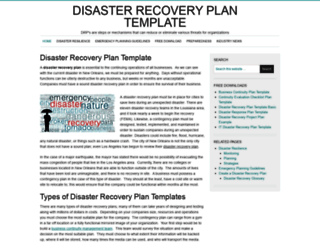Disaster Recovery Plan Template | Disaster Recovery Plan Downloads
Page Load Speed
5.7 sec in total
First Response
2.1 sec
Resources Loaded
3.4 sec
Page Rendered
251 ms

About Website
Welcome to disasterrecoveryplantemplate.org homepage info - get ready to check Disaster Recovery Plan Template best content for United States right away, or after learning these important things about disasterrecoveryplantemplate.org
Disaster Recovery Plan Template is a very important part of an organization, company or associations function. A Disaster Recovery Plan Template is the most important part of DRPs
Visit disasterrecoveryplantemplate.orgKey Findings
We analyzed Disasterrecoveryplantemplate.org page load time and found that the first response time was 2.1 sec and then it took 3.6 sec to load all DOM resources and completely render a web page. This is a poor result, as 60% of websites can load faster.